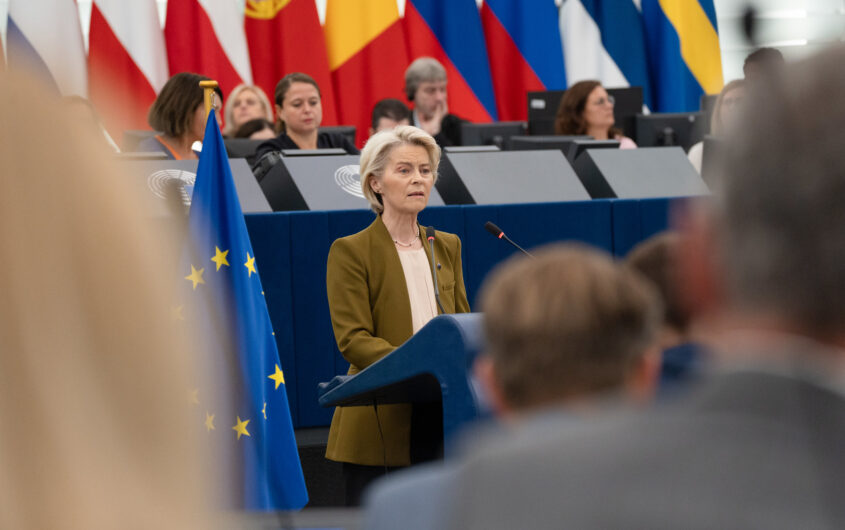
European Parliament via Flickr
From Bystander to Player?

Emily Benson
Minerva Technology Futures
Emily Benson is Head of Strategy at Minerva Technology Futures, where she advises clients on geopolitical risks that affect trade and investment decisions related to advanced technologies. She concurrently serves as a senior associate (non-resident) with the Europe, Russia, and Eurasia Program at the Center for Strategic and International Studies (CSIS). She previously served as a Senior Advisor at the U.S. Department of Commerce in a unit focused on geopolitical risk in critical supply chains. She also directed the Project on Trade and Technology at CSIS and worked in legislative affairs and international trade law in the transatlantic context. Her work has been featured in publications such as the New York Times, Washington Post, and Wall Street Journal, and on television, including the BBC, Bloomberg, and CNN. She is a Council on Foreign Relations Term Member and serves on the Board of Directors of the Association of Women in International Trade.
Europe’s strategic awakening in the age of supply chain risk
Tariffs have dominated the trade policy news cycle since the Trump administration took office. To date, the trade policy dynamic has focused largely on physical goods. This dynamic has also played out in export control policy and is increasingly spilling over into the digital domain. The confluence of American extraterritorial demands and Chinese control over critical supply chains has led Europe into a new chapter of strategic trade policymaking.
In October 2025, the Dutch government regained control over Nexperia, a semiconductor company owned by Chinese parent company Wingtech. While Nexperia produces non-sensitive analog chips that power car windows, its parent company was added to the U.S. Entity List in December 2024, meaning Wingtech—and therefore Nexperia—would become subject to the new U.S. Affiliates Rule, which subjects subsidiaries to the same restrictions as parent companies. The Affiliates Rule would have prohibited Nexperia from obtaining U.S. inputs, likely resulting in company closure.
The Dutch government began investigating Wingtech several years prior in a bid to rescue a foundational industry from a precarious path ahead, but the decision to claw back Nexperia has shone fresh light on mounting European concerns about the resiliency of its industrial base. It also raises serious questions about the ability of European governments to defend their industries against the extraterritorial endeavors of foreign governments.
This dynamic begs two fundamental questions for policymakers and the private sector in Europe. First, European policymakers need to identify major players in the EU technology and industrial policy landscape that could extend European geopolitical power over supply chains. Second, policymakers and private sector entities need to evaluate which companies may become subject to additional extraterritorial measures and whether these cases will make clawbacks more enticing.
Europe has often played a more muted role in global geopolitics. But the European Commission has recently launched efforts such as building a database to evaluate where it maintains chokepoints, which could be used as leverage during a geopolitical crisis. EU Director General for Trade Sabine Weyand recently told the European Parliament, “We have dependencies that others weaponize, but others are also dependent on us.”
Brussels must accept that strategic autonomy requires strategic courage.
The European Union maintains several key chokepoints if not outright monopolies. Europe dominates global shipping with major firms such as Maersk, MSC, and CMA controlling 33 percent of global container capacity. European banks—ING, Deutsche Bank, Natixis, Société Générale, and BNP Paribas—dominate commodity trade finance, accounting for roughly 70 to 80 percent of the global total. Europe also maintains the SWIFT global payment system, which undergirds modern financial transactions.
The European Union is also a major player in defense. BAE Systems provides support for GPS systems, naval systems, electronic warfare, and military vehicles. Alenia Aermacchi, a subsidiary of Italy’s Leonardo, produces a significant share of aircraft wings. SAP supports business steering and reporting software. Germany’s Rheinmetall production has expanded significantly, while defense tech startups like Helsing have moved with great urgency to refurbish the European defense industrial base. EU Member States also produce inputs critical to U.S. defense systems. Of F-35 components, 25 percent are manufactured in Europe.
Perhaps the most obvious point of EU leverage is ASML, which maintains a monopoly on extreme ultraviolet (EUV) lithography machines essential for cutting-edge chips. ASML suppliers also maintain significant leverage. German company Zeiss is the exclusive supplier of high-precision lenses and mirrors used in ASML’s most advanced tools. Zeiss supplies optics to ASML, which in turn supplies lithography machines to TSMC, Samsung, Intel, and others, in turn feeding companies like OpenAI, Microsoft, and Google. Trumpf is also a key ASML supplier, producing advanced machinery and industrial lasers. These key inputs demonstrate the deep interconnection of contemporary technology supply chains.
Discord Goes Digital
In addition to interdependence related to physical goods, the European Union will also need to contend with a more aggressive U.S. posture throughout the digital economy. Despite the EU-U.S. trade deal reached over the summer, the Trump administration has continued to pressure Europe over its digital regulations, including the Digital Services Act (DSA), Digital Markets Act (DMA), and digital services taxes (DSTs), policies President Trump has denounced as “designed to harm or discriminate against American technology.” In August 2025, President Trump warned that the United States would retaliate against countries imposing such measures, threatening tariffs and technology export restrictions.
Secretary of State Marco Rubio has instructed diplomats to lobby against the European Union’s digital framework, while Washington purportedly considered sanctions on European officials involved in drafting the legislation. United States Trade Representative Jamieson Greer told Congress that the United States “will not stand for discrimination against our champions in the tech space,” highlighting a readiness to weaponize trade policy in defense of Silicon Valley.
The United States can no longer afford to view its allies as secondary.
The State Department has since imposed visa bans on officials accused of censoring U.S. speech. Secretary of State Rubio has suggested possible targeting of officials regulating U.S. tech companies. The State Department has even explored linking export controls to DSA content removals, potentially treating speech as an export in a legally ambiguous application of export controls. These moves reflect an effort to reshape the postwar transatlantic order, deepening EU reliance on U.S. technology, while the United States pursues a maximalist approach to export its technology but under its own philosophical terms and conditions.
Benefits of Transatlantic Scale
Heightened transatlantic tensions come at an inconvenient time. In October 2025, China announced a new tranche of export restrictions on rare earth elements (REEs) in a new policy tool that closely mirrors the United States’ Foreign Direct Product Rule (FDPR). This announcement has caused widespread anxiety throughout developed economies and demonstrates the success of Beijing’s longstanding effort to amass foundational control over global supply chains.
As Kurt Campbell and Rush Doshi argued in Foreign Affairs, twenty-first century strategic advantage will accrue to powers who can operate at scale. China’s unparalleled industrial scale allows it to convert size into efficiency, productivity, and geopolitical leverage, a challenge unlike any the United States has faced before. In this environment, the United States can no longer afford to view its allies as secondary. Its ability to compete with China increasingly depends on strong and coordinated partnerships, particularly with Europe, whose industrial and technological strengths remain indispensable to maintaining Western strategic balance.
To maintain cutting-edge technology and also to retain a robust toolkit for geopolitical leverage in an increasingly complex world, the United States and European Union will continue to rely on interconnectedness for the benefits of scale. How they do this will be more complicated. First, the United States should de-escalate its digital policy threats, including directly discouraging any service disruptions, a reality that has led Denmark to de-risk from U.S. digital services. Second, the European Union will need to move closer to the United States on China policy, accelerating de-risking from Chinese companies, a trend already underway.
Recent actions by European governments, including not only the Netherlands’ control of Nexperia but also the UK’s takeover of the Scunthorpe steel plant (formerly owned by China’s Jingye Group), signal a shift toward greater scrutiny and potential rollback of Chinese ownership in sensitive sectors. If the Dutch precedent prompts other European governments to invoke similar “clawback” provisions, strategically valuable European companies already under Chinese control could be subject to nationalization, bailout, or re-acquisition.
Conclusion
A superior path for EU-U.S. cooperation is to recognize concrete value derived from two of the world’s largest economies. This will require Washington to recognize that its most valuable partner is not a subordinate, while Brussels must accept that strategic autonomy requires strategic courage. The chokepoints that matter in this century are not just in Silicon Valley, DC, Taipei, or the South China Sea; some of them run through Munich to Rotterdam.
The author would like to thank Venesa Rugova for her research support.








